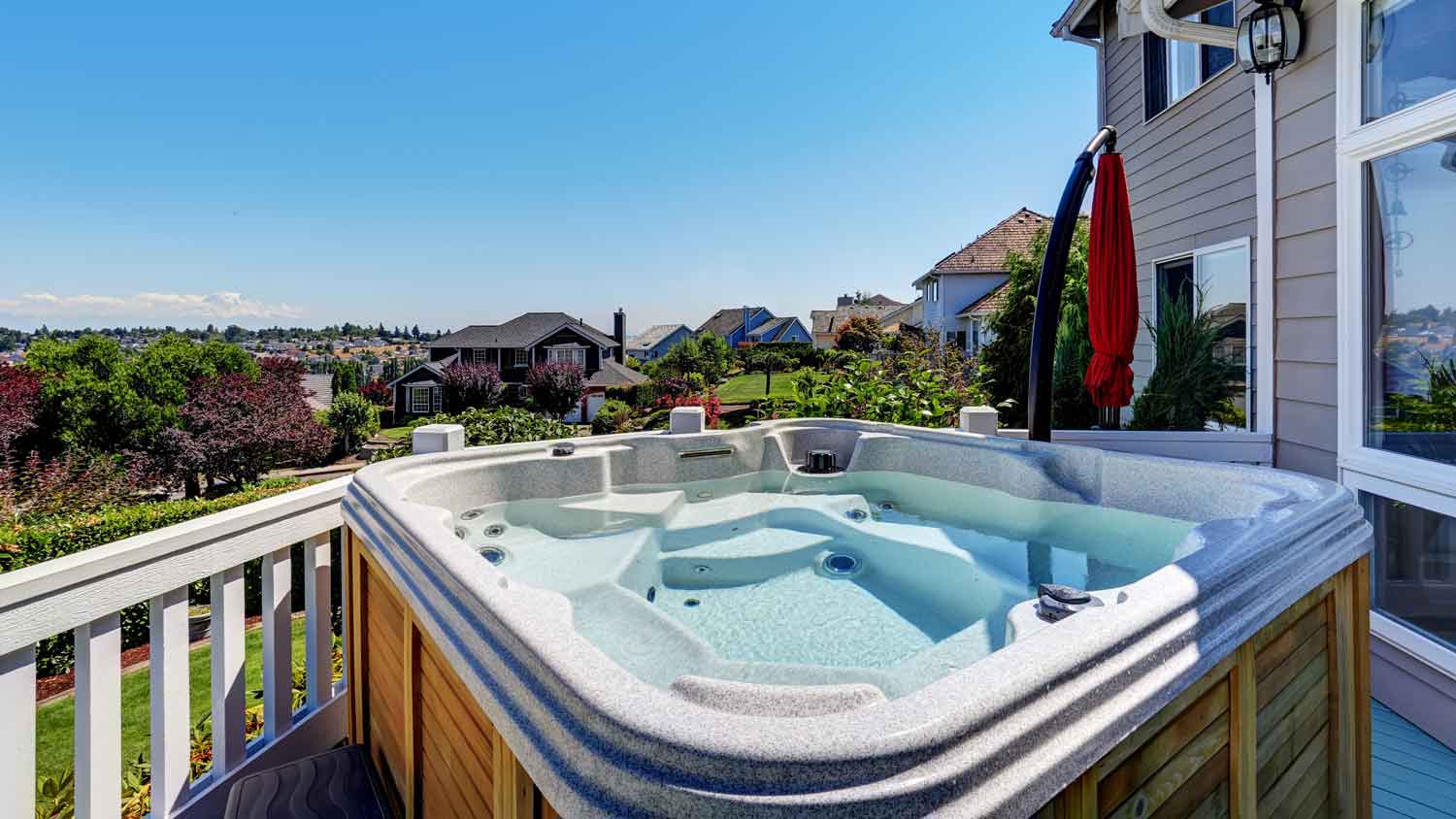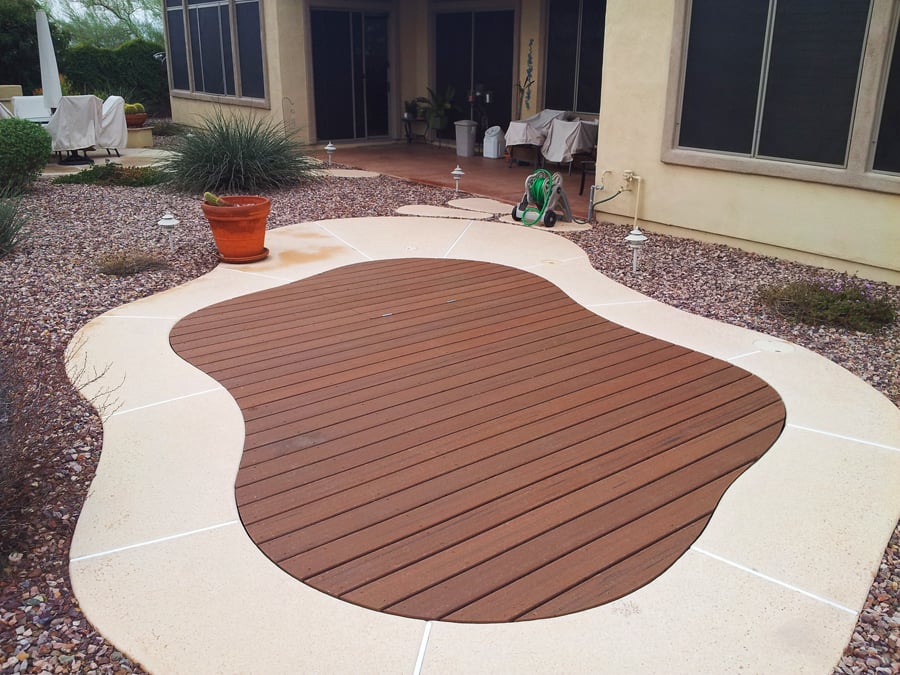
Discover how much a saltwater hot tub costs on average, including installation and ongoing expenses, plus tips to save money and compare DIY vs. pro options.
A deck over the pool takes it out of sight, out of mind


Building a deck over your pool will likely cost around $5,000, but prices may increase to $12,000 or more depending on your pool size and the deck material you choose.
Covering a pool instead of removing it can keep its equity.
Many people cover their pools because they can be a safety hazard for young kids or pets.
A swimming pool can transform your backyard into a personal oasis, especially on hot summer days. But it takes time and money to keep a pristine pool, and swimming pool maintenance costs can swell. Over time, what was once a treasured backyard feature can morph into a headache. If your pool has become an unsightly fixture or an expensive nuisance, you may consider a pool-to-deck conversion. Read on to learn about a deck over pool solution.
If you've decided that you no longer want your pool, you have another option besides filling it in or totally removing it—you can cover your pool with a deck. This is a common practice for homeowners who want to avoid the expense of replastering, filling in, or excavating their unused swimming pool. A pool-to-deck conversion gives you the benefit of a safe, covered pool area without the permanence of a solid deck built over the space.
It may be time to retire your pool if it's becoming more of a hassle than a pleasure. Here are four main reasons why homeowners opt for a pool-to-deck conversion:
An unused pool: It may seem obvious, but if you barely use your pool, and it takes up valuable space in your yard, you may be ready to call it quits. If you’re more interested in lounging on a deck instead of splashing in the water, it makes sense to convert your pool area into a deck.
Cost: A swimming pool’s average monthly maintenance cost is $110 to $350, depending on the size and type of the pool. Perhaps you’re looking to cut back on household costs, and your pool is simply not at the top of your priority list.
Safety: Pools can conjure safety concerns, from chemicals to drownings. Most drownings in kids aged one to four occur in swimming pools, according to the Centers for Disease Control and Prevention (CDC).
Water waste: Leaks and evaporation can lead to a significant amount of water use each year. This can be especially concerning if you live in an area with water restrictions.
Before installing a deck over a pool, it will have to be drained and cleaned. Try not to drain your pool until you have a plan ready. If your pool is left drained with no other measures in place, the floor can lift and the walls can fall in because of a lack of water pressure.

A pool-to-deck conversion allows you to keep the swimming pool's equity but remove the maintenance duties and safety concerns from your daily life. In certain areas of the country, a well-kept, inground swimming pool can increase your home's value by up to 7%. Installing an inground pool costs around $55,000 on average. If you think there's ever a chance you might sell your home, covering a pool with a deck could be a beneficial, financially sound option, as the decking can be removed.
There are a few drawbacks to covering a pool with a deck, especially if the deck is meant to be a temporary measure.
The two main disadvantages are the need to remove the deck and future resurfacing of the pool should you decide to use it again. Depending on how long the water was out of the pool, it might need to be resurfaced or replastered before you can use it again. The average cost to resurface a swimming pool is $6,500 for a 1,000-square-foot area. But this cost will depend on several factors, such as the pool's type and finish and materials needed to complete the project.
The cost for a pool-to-deck conversion depends on several factors, including the company or contractor you choose, the pool's shape and size, the deck's material, and the pool's surface. Compare quotes from a few different companies and contractors before making a decision. For context, a pool deck costs between $4,000 and $10,000 to install a 600- to 900-square-foot deck around an inground pool.

If a pool-to-deck conversion is unappealing or you’re unsure of what to do, there are other methods to safely and effectively retire your pool. Investing in a sliding deck could give you seasonal access to your pool, while alleviating some maintenance and safety concerns. You could also create a new version of a backyard oasis by turning the space into a garden. If all else fails, there’s the option of removing the swimming pool from your property.
Sliding deck pool covers come in varying shapes, sizes, and designs, but one characteristic remains the same—it provides a hard surface that slides over the pool. Often, these materials are strong enough to support patio furniture.
These decks give you more usable space, increase safety, and protect the pool. Sliding decks can be expensive, ranging in cost from $25,000 to $75,000—in many cases, the amount rivals what it costs to install an inground pool.
This might be an option if you have a thriving green thumb and would like more gardening space. Before starting this project, check to see if there are any needed permits. Also, if you decide to sell your home, you may have to disclose that the greenhouse was once a pool. This project will require you to drill holes in the bottom of the pool for drainage. Plus, you might consider removing any decking around the area.
Once your yard has recovered from the demolition process, removing an inground pool would eliminate maintenance costs and safety issues. It takes a lot to install an inground pool, so removing one can be a fairly large-scale project, involving contractors and possibly requiring a demolition permit. The removal cost can range between $2,700 and $19,000, depending on the pool’s size and depth, but most homeowners will pay an average of $6,000.
He requested I review his service, so I am following through. This week was the second service. I told him that our particular needs were that the trash cans in the living room, kitchen, and my bedroom be emptied. I explained what should go in recycling and which should go in garbage bin...
All Complete Construction is very professional and helpful roof company. They care about what they do and provide excellent customer service. Sam is the great person. Their office staff was super positive, helpful and attentive. Wouldn t hesitate to call them again when we need roof chimney...
I've been wanting to have my home redecorated and I wanted to start with my front lawn. They had great ideas of putting in a new kind of landscaping design and concrete curbs. Great service and very creative team!
I needed a kitchen and bathroom remodeling and these guys were the best people I could choose. They took my vision and brought it to life! Amazing customer service.
It was good service. They were on time, did everything in a timely manner, there were no damages per se and no hidden charges. I will call them in the future and would recommend to all that I know.
What a nice job. Roger the foreman was kind to me and made my life easier. Their availability is 24/7. The Customer service department provided status without having to ask for it. I would definitely recommend their service to my friends.
From average costs to expert advice, get all the answers you need to get your job done.

Discover how much a saltwater hot tub costs on average, including installation and ongoing expenses, plus tips to save money and compare DIY vs. pro options.

Wondering how much it costs to run a hot tub? Discover average monthly and yearly costs, key factors, and tips to keep your hot tub expenses in check.

We could all use some relaxation, but we don’t always have the budget. This guide will show you how much an in-ground hot tub costs—no matter the build.

Winterizing your hot tub during colder periods helps prevent potential damage caused by freezing. Learn how to winterize a hot tub.

Common reasons for pool jets not working include clogs, low water levels, and air leaks. Read this to learn what’s causing your jet problem and how to fix it.

Discover how much a pool vacuum costs, including average prices, installation, and maintenance factors to help you budget for a cleaner pool.